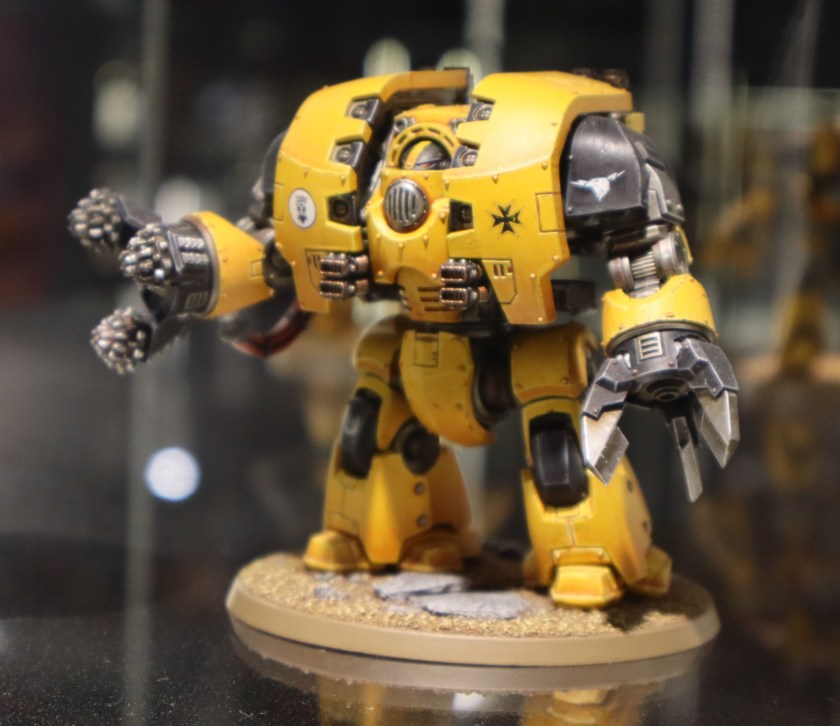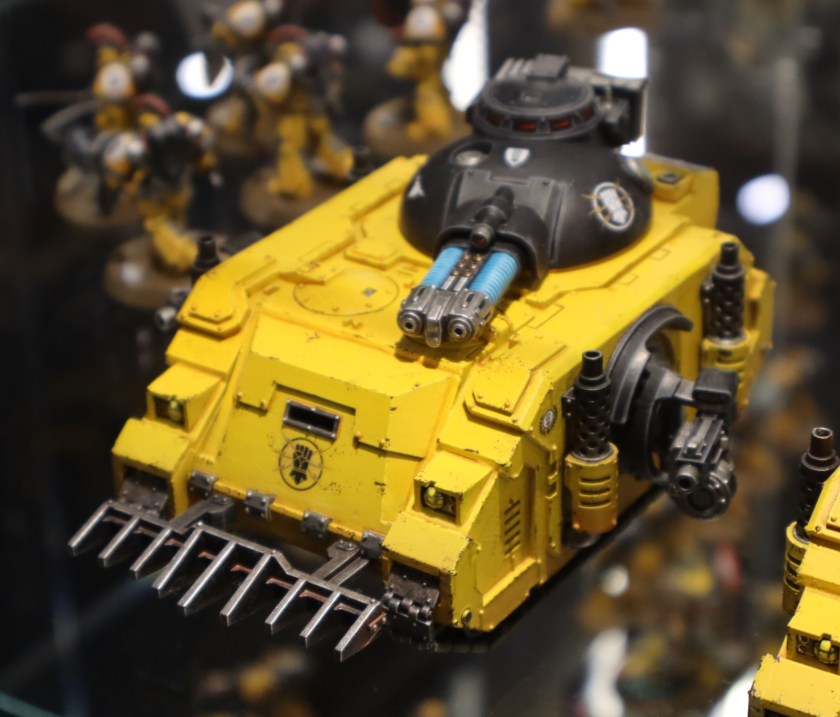The Shadowsword is the sister tank to the Baneblade, a super-heavy vehicle employed by Solar Auxilia cohorts to engage and destroy enemy macro-engines with its volcano cannon. The same chassis has also been adapted to mount different primary weapons suited to their own modes of destruction, like the bunker-busting Stormsword siege cannon or the versatile plasma blastgun of the Stormblade.
Category: warhammer the horus heresy
Imperial Fists Scimitar Jetbikes
The Scimitar Jetbikes of the Age of Darkness are modifications of complex pre-Imperium designs.
Leviathan Siege Dreadnought
Heavily-armed and impressively armoured, the Leviathan Siege Dreadnought is an alternative development of the highly successful Contemptor design.
These rare and mighty engines are prized by Astartes commanders, recognised as savagely powerful siege and hunter-killer units that can crush any opposition with an unstoppable wrecking charge. Yet such overwhelming strength comes at a cost – a Leviathan’s systems place an onerous and ultimately lethal strain upon its occupant, the entombed incumbent burning brightly but only briefly in their second life.
Imperial Fists Deimos Pattern Predator
The Predator is perhaps the best known and most widespread variant of the basic Rhino chassis. Augmented with superior armour and firepower, it entirely sacrifices the Rhino’s troop transport capacity in favour of ammunition and generators for its formidable weapon systems.
The Deimos Pattern Predator Battle Tank is a versatile and effective armoured vehicle commonly used by the Space Marine Legions during the Great Crusade and Horus Heresy. Based on the ubiquitous Rhino chassis, it sacrifices troop transport capacity for enhanced firepower and armour.
The tank can be configured with a variety of weapons. For the Imperial Fists Legion, specifically, the tank is particularly effective when equipped with the autocannon and heavy bolter configuration, which benefits from their Legion trait that grants a bonus to hit rolls.
More photographs of the Deimos Pattern Predator.
Imperial Fists Deimos Pattern Rhino
This Imperial Fists Deimos Pattern Rhino was in the display cabinets at Warhammer World.
The Deimos Pattern Rhino is an iconic and reliable armoured personnel carrier used extensively by the Space Marine Legions during the Great Crusade and Horus Heresy. For the Imperial Fists, a Legion renowned for its expertise in siegecraft and fortified defence, the Deimos Pattern Rhino is a fundamental part of their armoured columns.
Its robust design, based on ancient Standard Template Construct (STC) technology, makes it well-suited for the relentless, grinding warfare that defines the Imperial Fists’ combat doctrine. The Rhino can transport a full 10-man squad of Legionaries, shielding them with its thick armour as it carries them swiftly across the battlefield. While the vehicle is primarily a transport, it can be equipped with various pintle-mounted weapons, such as a heavy bolter, multi-melta, or a havoc launcher, adding to the Imperial Fists’ already formidable firepower. The model kit for this vehicle often includes a transfer sheet with specific markings for the Imperial Fists and other legions, allowing hobbyists to easily customise their models.
More photographs of the Deimos Pattern Rhino.
How I painted my Imperial Fists Deimos Pattern Rhino.
Imperial Fists Deimos Pattern Vindicator
The Deimos Pattern Vindicator is a heavily armoured siege tank widely used by the Space Marine Legions during the Great Crusade and Horus Heresy.
A variant of the Deimos Pattern Rhino chassis, it sacrifices its transport capacity for a powerful, hull-mounted main weapon. The Vindicator is particularly effective in urban combat, where its primary armament—typically a demolisher cannon—can be used to destroy fortifications, breach obstacles, and clear out dense infantry formations.
For the Imperial Fists, the Vindicator is a fitting choice, as their legion specialises in siege warfare and tearing down enemy defences. In addition to the demolisher cannon, the Deimos Pattern Vindicator can also be equipped with a magna laser destroyer, turning it into a formidable anti-tank vehicle capable of taking on super-heavy tanks and even Titans. Both load outs are highly effective and are complemented by the tank’s iconic dozer blade, which allows it to push through rubble and barricades with ease.
More photographs of the Deimos Pattern Vindicator.
Imperial Fists Fellblade
This Imperial Fists Fellblade Super-Heavy Battle Tank was on display at Warhammer World.
The Fellblade is based on the same Standard Template Construct pattern as Baneblade super-heavy tanks, equipped with advanced weapon and armour systems befitting the Legiones Astartes. This formidable mainline tank employs many technologies restored to humanity by the Great Crusade – from its reinforced metaplas alloy chassis and atomantic arc-reactor to its powerful accelerator cannon and battery of explosive shells.
More photographs of the Imperial Fists Fellblade Tank from previous visits to Warhammer World.
More photographs of the Fellblade Tank.
Imperial Fists Kratos Heavy Assault Tank
The Imperial Fists, with their unwavering dedication to siege warfare and their role as the Emperor’s Praetorians, made extensive use of the Kratos Heavy Assault Tank during the Horus Heresy. This formidable vehicle, based on a design from the Unification Wars, perfectly embodied the Legion’s philosophy of indomitable offence and defence. Its thick ceramite armour and array of heavy weaponry—including the versatile Kratos battlecannon, melta blast-gun, or volkite cardanelle—allowed it to spearhead assaults and break enemy lines with a methodical and relentless advance. For the Imperial Fists, the Kratos was not merely a tank but a mobile fortress, a bastion of Imperial might designed to withstand the most brutal enemy fire and deliver overwhelming firepower in return, a reflection of their own resilient nature.
More photographs of the Imperial Fists Kratos Heavy Assault Tank from previous visits to Warhammer World.
More photographs of the Kratos Heavy Assault Tank.
The Kratos’s role within an Imperial Fists army was primarily that of a “line-breaker” and “foe-hammer.” It was a vehicle designed to advance with their infantry formations, providing crucial fire support and acting as a bulwark against counterattacks. The Legion’s master builders and siege engineers would often customise these tanks with additional armour plating and dozer blades, further enhancing their durability and enabling them to clear a path through battlefield debris and fortifications. The Imperial Fists’ Kratos tanks were an integral part of their armoured columns, working in concert with other heavy vehicles to lay siege to enemy strongholds and grind their foes into submission, a testament to the Legion’s mastery of armoured warfare and their unyielding resolve.
How to paint the Horus Heresy Imperial Fists Deimos Pattern Rhino
A nice painting guide on how to paint an Imperial Fists Deimos Pattern Rhino.
The Deimos Pattern Vindicator is a heavily armored siege tank widely used by the Space Marine Legions during the Great Crusade and Horus Heresy. A variant of the Deimos Pattern Rhino chassis, it sacrifices its transport capacity for a powerful, hull-mounted main weapon. The Vindicator is particularly effective in urban combat, where its primary armament—typically a demolisher cannon—can be used to destroy fortifications, breach obstacles, and clear out dense infantry formations. For the Imperial Fists, the Vindicator is a fitting choice, as their legion specializes in siege warfare and tearing down enemy defenses. In addition to the demolisher cannon, the Deimos Pattern Vindicator can also be equipped with a magna laser destroyer, turning it into a formidable anti-tank vehicle capable of taking on super-heavy tanks and even Titans. Both loadouts are highly effective and are complemented by the tank’s iconic dozer blade, which allows it to push through rubble and barricades with ease.
How I painted my Imperial Fists Deimos Pattern Rhino.
Imperial Fists Arquitor Bombard with Spicula Rocket System
Seen at Warhammer World, this Imperial Fists Arquitor Bombard is a prime example of the formidable heavy artillery used by the Legiones Astartes.
The Legion Arquitor is built to spearhead an assault, its reinforced chassis allowing it to operate on the front lines. This mobile fortress brings immense, short-range firepower to bear, making it the perfect tool for cracking enemy strongholds or obliterating dense concentrations of infantry and armoured vehicles.
This particular model is equipped with the Spicula Rocket System, a devastating weapon that unleashes a storm of unguided missiles. These rockets rain down in massive salvos, creating cumulative explosions that can decimate entire enemy formations in a single, cataclysmic volley.































